Pensacola Country Club, FL
by Bill McBride
The history of Pensacola Country Club is quite interesting. Founded in 1902, it’s the oldest private golf club in Florida. The first nine was first laid out by two amateur members. A second nine was added in 1925, when the club purchased a large waterfront home built in the 1920’s as the clubhouse.
The second nine, and in fact the entire course, was built much in the style of Donald Ross, with pushed-up, small greens that required delicate chipping skills, and a general ambience reminiscent of Pinehurst with its pine-straw and sand rough and pine-lined fairway corridors.
Over the years, the condition of the course deteriorated due to an aging irrigation system, a tight-fisted membership, and the flat location on Pensacola Bay at just above sea level. Drainage became a serious issue. At times the course was barely playable, and carts had to be kept off the course. In the hot, humid summers on the Gulf Coast, this effectively closes the course! The course was challenging in its way, hosting first round PGA Tour Schools from 1996-2004, but it was beyond its prime and desperately needed at least a facelift.
In September 2004 came the deus ex machina in the form of Hurricane Ivan to solve the dilemma. Over 3,000 trees were downed and the course was submerged in salt water for days. The membership underwent an arduous decision process before electing to proceed with a complete redo of the golf course.
Jerry Pate, who volunteered to do the design work for no fee, grew up as a member of Pensacola Country Club. His design firm is a serious participant in golf architecture these days, with the #1 and #2 public access courses in Alabama (Limestone Springs and Kiva Dunes), highly rated courses in Mississippi (Dancing Rabbit and Old Waverly), and the neighboring Steelwood Country Club, a solid if difficult private club in southern Alabama. Jerry is justifiably proud of the work he has done in designing the new PCC.
The construction was well-planned. Over the years, the flattish course with a very high water table had become mucky with leaky irrigation and bad drainage. The construction plan involved turning all the fairways, getting a layer of sand above the muck, and excavating acres of lakes and placing all the excavated sand on top of the fairways. This enabled the designers to add a lot of contour to the fairways and raise the entire course over 12′. The resulting drainage is very good, even during a typical Gulf Coast downpour.
The new course opened November 9th of 2006 after a year of wrangling and a year of construction, on budget and on time. The course is a modern rendition of the old Ross feel, with greens averaging 30% larger; wider, fast and firm fairways; and flat-bottomed bunkers with grass faces. There are a number of classic design features — a reverse Redan with a Biarritz twist in the green, a cape hole with a punchbowl green, several fall away greens, and in general a lot of strategic decisions to be made.
The proof of any renovation or remodeling project has to be the satisfaction of the members, and to date I have not heard anybody say, “We want the old course back!” The drainage is excellent, the new greens (Tifdwarf) are excellent, and the fairways (419) are firm, fast and make great surrounds with many ground game options.
To me one of the things that makes this an outstanding course is that there are no two holes even slightly similar to the others; every hole is unique and individual.
Hole-by-hole description, yardages are from the blue tees, one forward from the tips:
#1 “ a solid get away, this hole plays 435 yards with a gentle dogleg left, to a deep green set at a 30 degree angle to the right. This one is fun, as the downwind approach can be played on the ground or in the air.
#2 “ a very good dogleg right par 4, 395 yards, a hard dogleg right with the tee shot across a lake with a wide fairway bunker on the far bank of the pond. Two large bunkers in the dogleg require a tee shot to the left, as the carry is 290 yards across the corner. Trees (some of the remaining pines) further block shots played to the right. The green is uphill for half its 30 yard depth, then downhill behind a ridge. A running approach is very effective to the back pins.
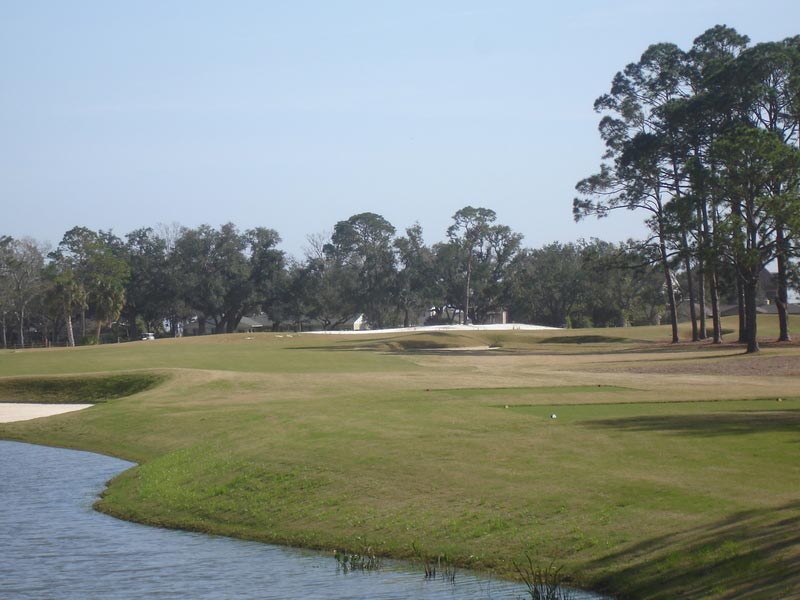
The approach to the second.
#3 “ a straight, short par 4, the cross bunker at 280 yards protects this 340 yard hole very effectively, as any tee shot within 150 yards of the green must be played to a blind green. You can just see the top of the flag, so every approach shot is played with less than 100% confidence, as distance is uncertain, and a deep bunker and lake wait behind the green.

Third green as seen from the tee shot landing area, just the top of the flag visible.
#4 “ a par 3, 175 yards, with a green set at 30 degrees right to left, elevated above a lake to the left. The only bunker stops some pulled shots from going in the water. This hole is best played with a high shot or soft draw, as the green falls away right to left, which is most fun when the pin is set back left and you can watch the ball rolling in that direction.

The fourth green.
#5 “ another short par 4, 345 yards, a dogleg left around a pond with no bunkers. The hole plays gently uphill to a volcano green with a steep falloff left toward the water. This tiny green “ maybe 3,000 SF “ is firm and the running approach is sometimes the only way to get close to the hole. This is a real throwback hole, you don’t see many of these anymore.
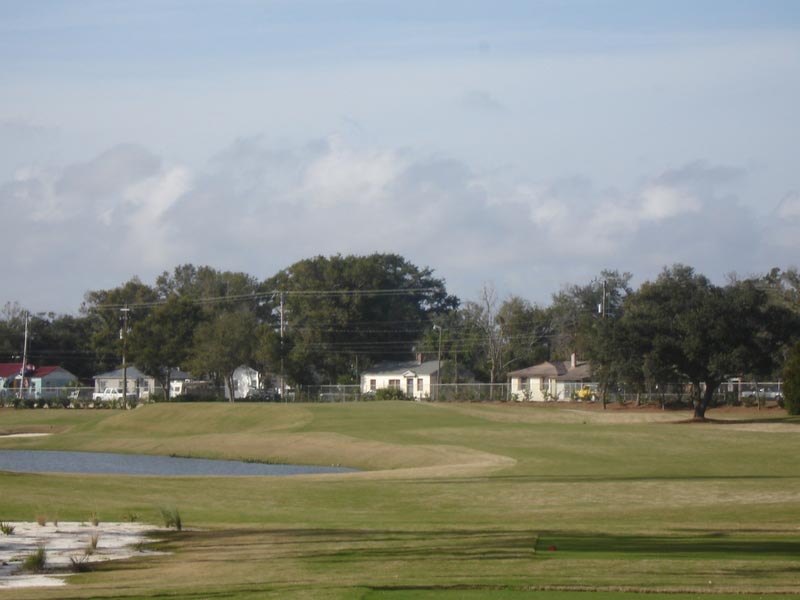
Tee shot at the fifth
#6 “ this is the #1 handicap hole, a 535 yard par 5 played into the prevailing wind, with a long lake all the way down the right side, OB left and a series of fairway bunkers on the left side. The landing areas are generous but the water continually beckons to the slicer. The green is another fall away design, with good pin positions in the back right, hidden behind the greenside bunker.

Tee shot at six
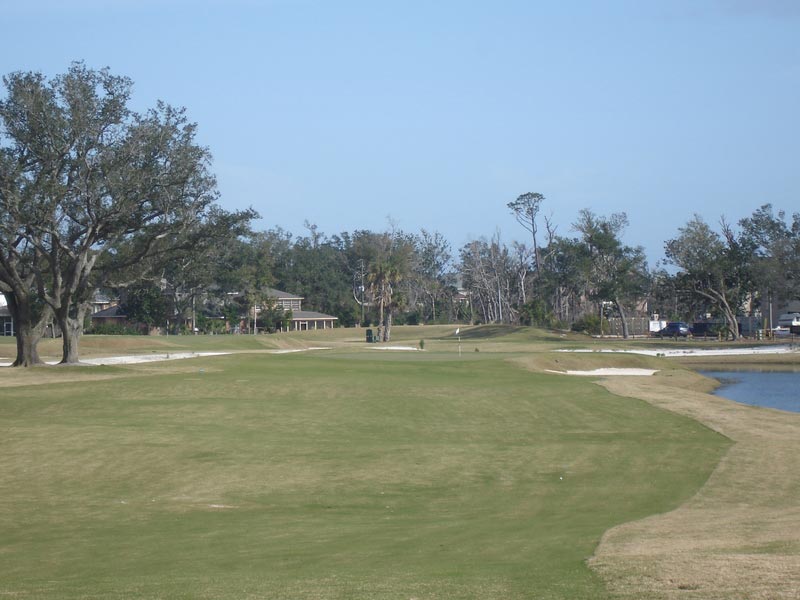
Approach to the sixth
#7 “ the Reverse Redan with Biarritz twist! When I first talked to Jerry Pate about the new layout, I suggested semi-seriously that he build us a Redan. “You know what a Redan is?!” So we got this beauty, which is 245 from the tips, 215 from the blues, with a slight slope on the left side which definitely moves the running tee shot down onto the green. Again, it’s fun to watch. There is a swale in the middle of the green which could invite stronger players to fly the ball onto the green, but I’ve seen very few aerial approaches hold this green.

The seventh green “ the ball closest to the pin got there via the reverse Redan route, landing short left and kicking off the slope down toward the flag.
#8 “ par 5 that replaces the most boring hole on the old course. GCAers who have played the old PCC will remember #8 as the short par 5 with fairway bunkers left and right at 260 yards and a muddy ditch directly in front of the green. The new hole is a bit longer at 500 yards and plays around a large hillside created using spoil from the new lakes and featuring four deep fairway bunkers on that hillside. There is a new pond front and left of the small green which is angled to the left behind the pond. Tee shots that don’t get near the ridge of that hillside leave blind second shots to a small green with water left and a deep bunker right. Second shots bailed to the right leave very difficult pitches, so the members are learning where to place their second shots for the approach pitches. Some haven’t learned the lessons yet and continue to struggle with the hazards left and right.
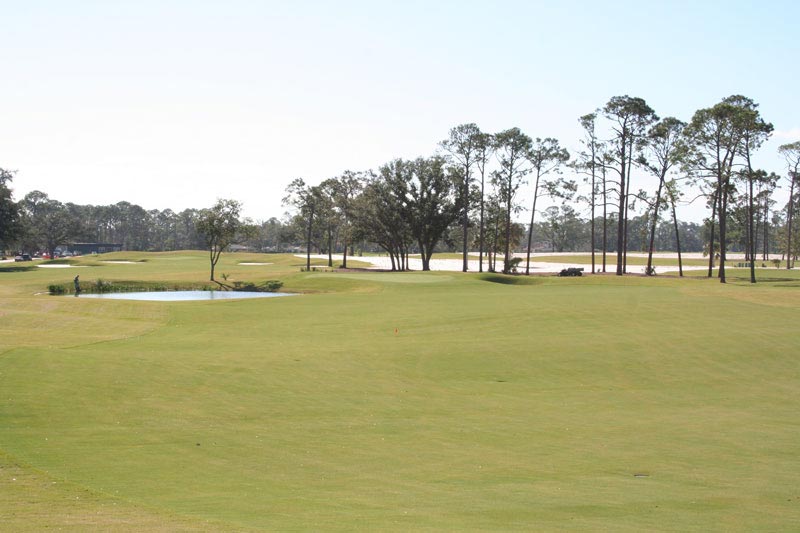
Eight green as seen from the top of the ridge “ well past all but the longest tee shots
#9 “ a very straight forward par 4, 390 yards, with OB left, played between fairway bunkers to one of the most interesting greens on the course. This green has a ridge running from 11 o’clock to 5 o’clock that is pretty steep, so that putts across the ridge are very difficult. The ridge also requires a carefully placed tee shot so that the approach angle is from the correct side of the fairway depending on pin location.
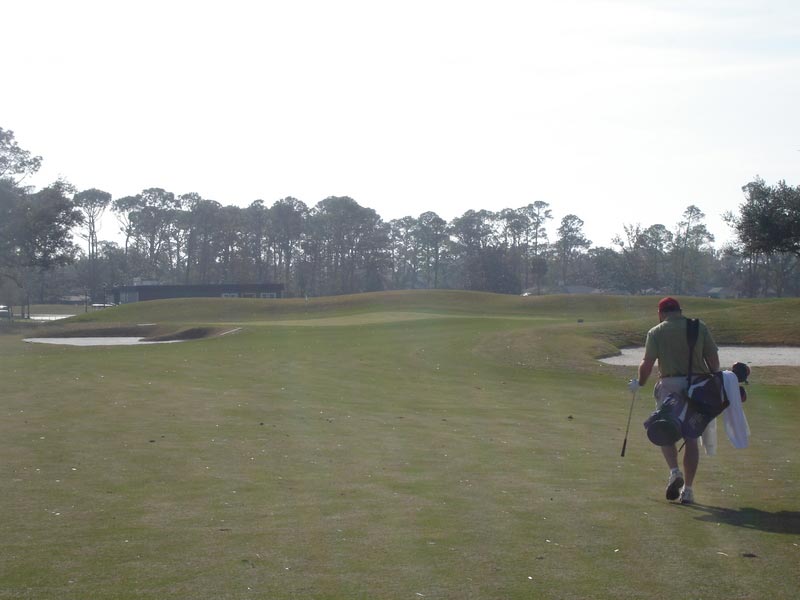
The ridge through the ninth green
#10 “ Another short par 4, 344 yards from the blue tees. The hole plays slightly uphill with a lake on the left and fairway bunkers at the bottom of a slope toward the lake. The green sits below the fairway level so can be somewhat blind, but the major difficulty with scoring birdies here is the firm, steeply falling away green. Sometimes the best approach is with the putter, as the 419 fairway turf is firm and fast.
#11 “ A short par 3 with a forced carry across the lake to a green with another ridge, this one dividing the green’s left and right sides. With the prevailing wind in your face, the 150 yard tee shot can be vexing, as the green is small, there’s a deep pot bunker and the lake in front, and the ridge ready to throw your shot well away from the hole if the shot is off line.
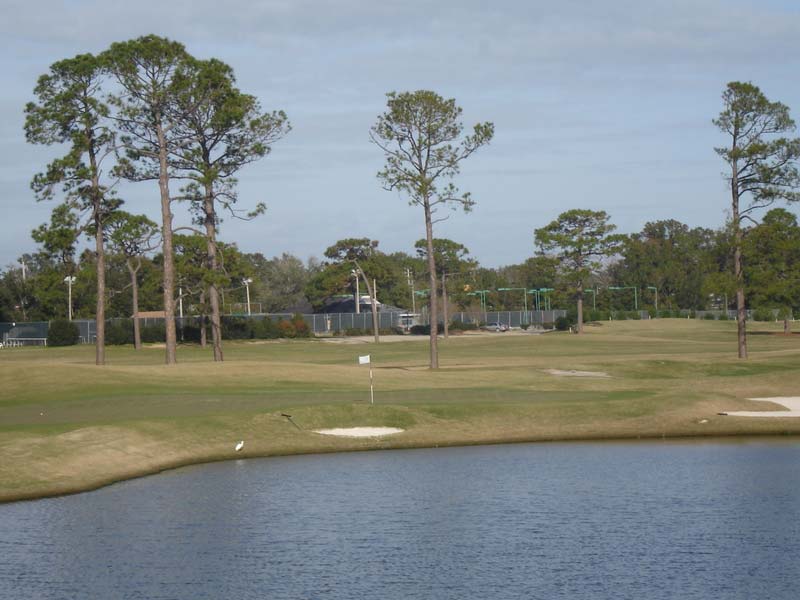
The eleventh green
#12 “ Probably the easiest birdie on the course, this par 5 is 515 yards and doglegs slightly to the right around a large and deep fairway bunker. The green sits below a mounded area to the left and a hollow to the right, but the short approaches can be negotiated, and the longer hitters have been home in two quite a bit with the hole playing generally downwind.
#13 “ 410 yard par 4 back into the wind, across a large waste area to a wide fairway leading to a large green with no bunkers but protected by a lake on the immediate left side. This hole replaces one redesigned several years ago by Tom Fazio, but this one plays better, I think, because of the running shots that can be played into the slope from the right. This is one of three difficult par 4s on the back nine.
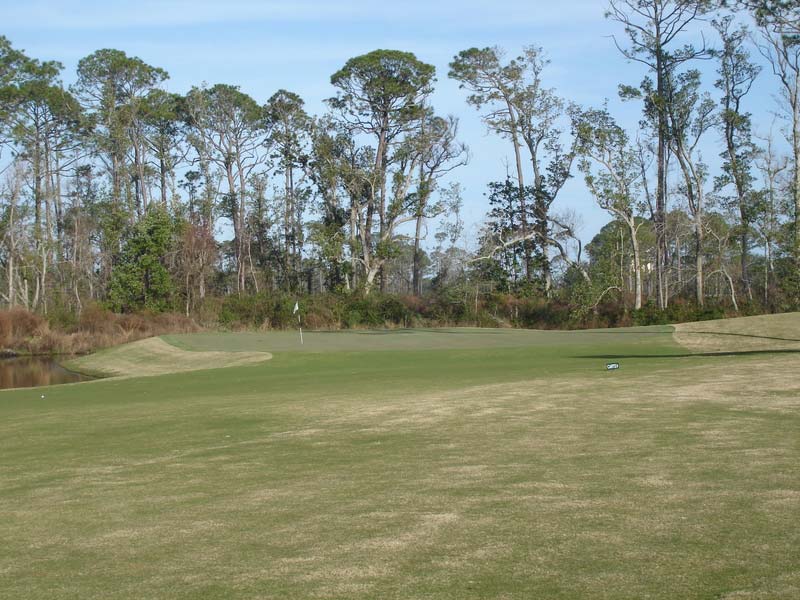
Approach to the thirteenth green
#14 “ 515 yard par 5, again downwind, with a carry across a lake and bunker to the optimum landing zone. The fairway splits about 150 yards out, requiring a decision to play left of a nasty pot bunker to a more difficult pitch, or right to an upper fairway which yields an approach down the axis of the green. It is helpful to play to the right side, as the green falls off sharply at the rear and is quite difficult to approach from the left fairway. Bunkers directly in front of this green further complicate the decision based on pin location.

Decision point at fourteen “ safe left fairway to a shorter but more difficult pitch, or right fairway for an easier shot? From the right side of the fairway, trees block the way and require a fade.
#15 “ A strong par 4, 410 yards, played to a flattish green that gently slopes to the back, across a creek directly in front. This creek always reminds me of the Scottish golfer who hits his second to such a green and cries out, “Did ma ball carry over the bonnie wee burn, or is it in that filthy, mucky ditch?” The creek requires a strong tee shot to be comfortably carried, so this is a demanding hole in the finishing stretch.
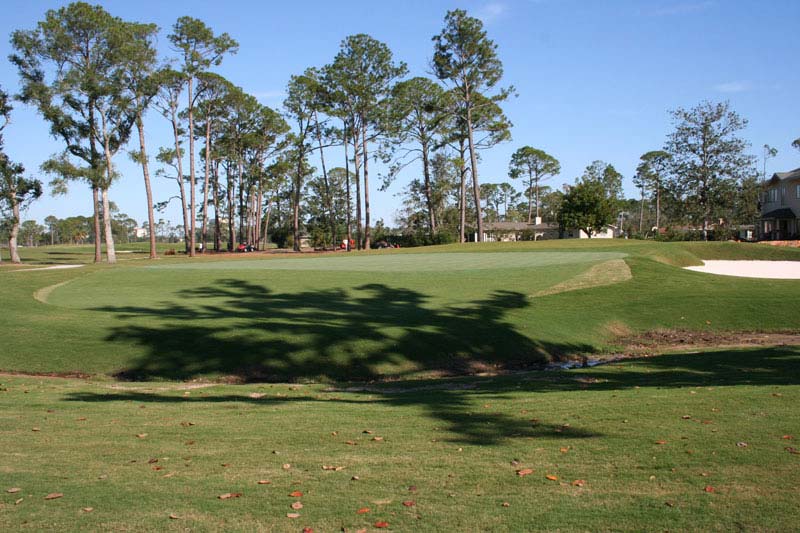
The ditch in front of the fallaway green at fifteen
#16 “ the fourth short par 4 – !! “ plays 295 from the blue tees, 303 from the tips, over a sandy wasteland with a marsh left and deep bunkers right, to a slightly elevated, tiny green that features two tiers with a steep slope between. There are so many different ways to play this hole. One way not to play it is the aggressive draw that finds the junk left; another is to push the tee shot and wind up behind, or worse, in one of the deep bunkers on that side. This is an outstanding little risk-reward hole.

Tee shot at short par four sixteenth
#17 “ 420 yards from the blues, 458 from the tips, a cape tee shot across the long lake that was left of #10. OB right must be considered, so the tee shot into the prevailing wind is of great concern. The green is an excellent rendition of the punchbowl, with a blind shot into a large green of perhaps 7,000 SF, that includes a rear tier and a swale crossways in the green. Hitting a running shot into #17 and walking up to see where it finished is as fun as golf gets.
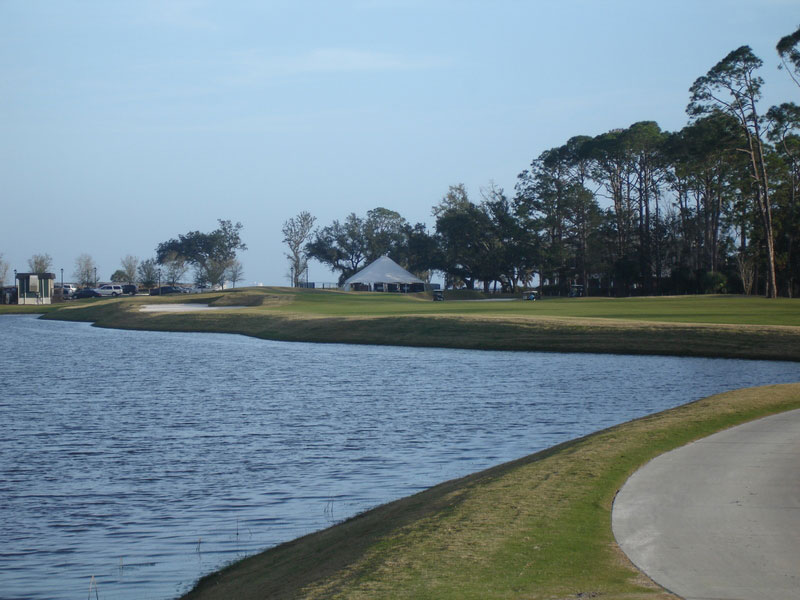
Cape tee shot at seventeen
#18 “ the piece de resistance. PCC didn’t have any holes on the water in its original configuration, but Jerry Pate suggested this hole would be the “signature” hole of the new golf course and be an attraction of the club for many years. The resulting par 3, some 160 yards to an elevated skyline green with Pensacola Bay the backdrop, is stunning, with deep bunkers left and right and a deeper than apparent green. Balls right and/or long have every opportunity to find the bay. Played into the prevailing wind, shots to rear pins must be played at 3 clubs more than the center pin position would seem to require.
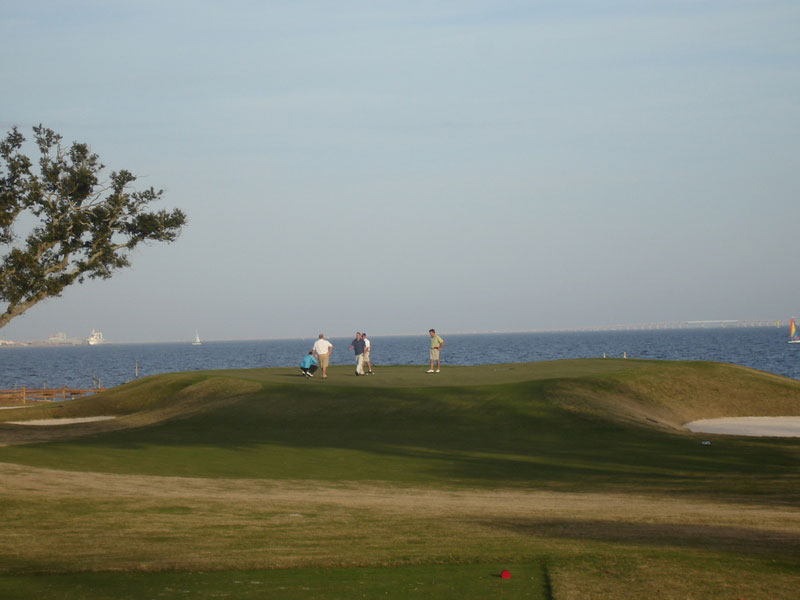
The finishing hole at PCC
I believe Pensacola Country Club’s new course for this new century is an outstanding update, a very good course on what could realistically be called a humdrum piece of land. I look forward to hearing from GCAers who would like to visit and experience the course themselves.
The End







